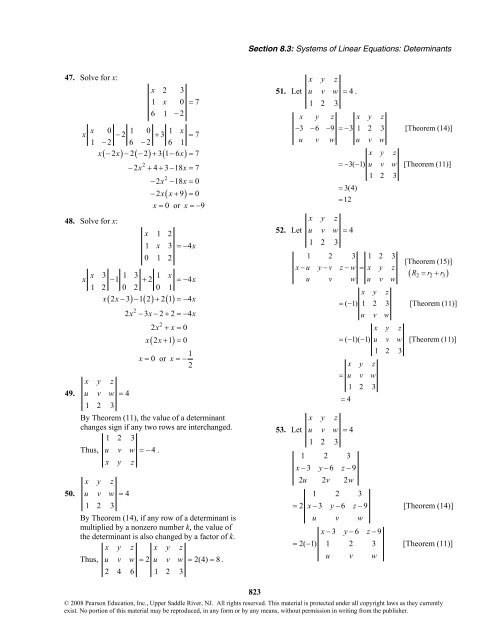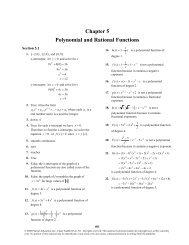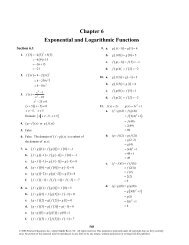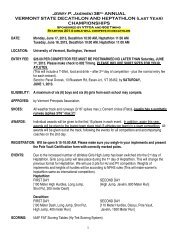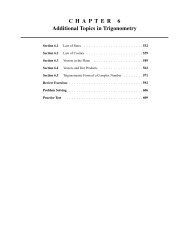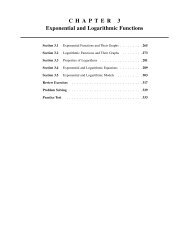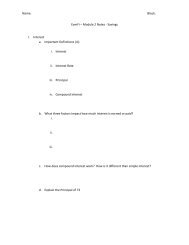Chapter 8 Systems of Equations and Inequalities
Chapter 8 Systems of Equations and Inequalities
Chapter 8 Systems of Equations and Inequalities
You also want an ePaper? Increase the reach of your titles
YUMPU automatically turns print PDFs into web optimized ePapers that Google loves.
47. Solve for x:<br />
x 2 3<br />
1 x 0 = 7<br />
6 1 − 2<br />
x<br />
x<br />
1<br />
0<br />
−2 − 2<br />
1<br />
6<br />
0<br />
−2<br />
+ 3<br />
1<br />
6<br />
x<br />
1<br />
= 7<br />
x( −2x) −2( − 2) + 3( 1− 6x) = 7<br />
2<br />
− 2x + 4+ 3− 18x = 7<br />
2<br />
−2x − 18x = 0<br />
− 2x x+<br />
9 = 0<br />
48. Solve for x:<br />
( ) ( ) ( )<br />
2<br />
( )<br />
x = 0 or x =− 9<br />
x 1 2<br />
1 x 3 =−4x<br />
0 1 2<br />
x<br />
x<br />
1<br />
3<br />
− 1<br />
1<br />
2 0<br />
3<br />
+ 2<br />
1<br />
2 0<br />
x<br />
1<br />
=−4x<br />
x 2x−3 − 1 2 + 2 1 =−4x<br />
x y z<br />
49. u v w = 4<br />
1 2 3<br />
2x−3x− 2+ 2=−4x 2<br />
2x + x = 0<br />
x 2x+ 1 = 0<br />
( )<br />
1<br />
x = 0 or x =−<br />
2<br />
By Theorem (11), the value <strong>of</strong> a determinant<br />
changes sign if any two rows are interchanged.<br />
1 2 3<br />
Thus, u v w =− 4 .<br />
x y z<br />
x y z<br />
50. u v w = 4<br />
1 2 3<br />
By Theorem (14), if any row <strong>of</strong> a determinant is<br />
multiplied by a nonzero number k, the value <strong>of</strong><br />
the determinant is also changed by a factor <strong>of</strong> k.<br />
x y z x y z<br />
Thus, u v w = 2 u v w = 2(4) = 8.<br />
2 4 6 1 2 3<br />
Section 8.3: <strong>Systems</strong> <strong>of</strong> Linear <strong>Equations</strong>: Determinants<br />
823<br />
x y z<br />
51. Let u v w = 4 .<br />
1 2 3<br />
x y z x y z<br />
−3−6− 9 =−312<br />
3 [Theorem (14)]<br />
u v w u v w<br />
x y z<br />
=−3( −1)<br />
u v w [Theorem (11)]<br />
1<br />
= 3(4)<br />
= 12<br />
2 3<br />
x y z<br />
52. Let u v w = 4<br />
1 2 3<br />
1<br />
x−u u<br />
2<br />
y−v v<br />
3<br />
z− w<br />
w<br />
1<br />
= x<br />
u<br />
2<br />
y<br />
v<br />
3<br />
z<br />
w<br />
[Theorem (15)]<br />
( R2 = r2 + r3)<br />
x y z<br />
= ( −1)<br />
1 2 3 [Theorem (11)]<br />
u v w<br />
x y z<br />
= ( −1)( −1)<br />
u v w [Theorem (11)]<br />
1 2 3<br />
x y z<br />
= u v w<br />
1 2 3<br />
x y z<br />
© 2008 Pearson Education, Inc., Upper Saddle River, NJ. All rights reserved. This material is protected under all copyright laws as they currently<br />
exist. No portion <strong>of</strong> this material may be reproduced, in any form or by any means, without permission in writing from the publisher.<br />
= 4<br />
53. Let u v w = 4<br />
1 2 3<br />
1 2 3<br />
x−3 y−6 z−9<br />
2u 2v 2w<br />
1 2 3<br />
= 2 x−3y−6z−9 [Theorem (14)]<br />
u v w<br />
x−3 y−6 z−9<br />
= 2( −1)<br />
1 2 3 [Theorem (11)]<br />
u v w


